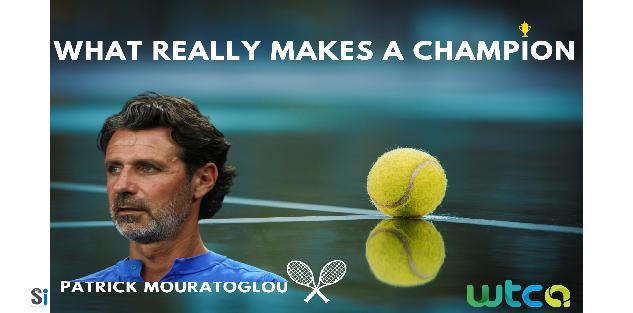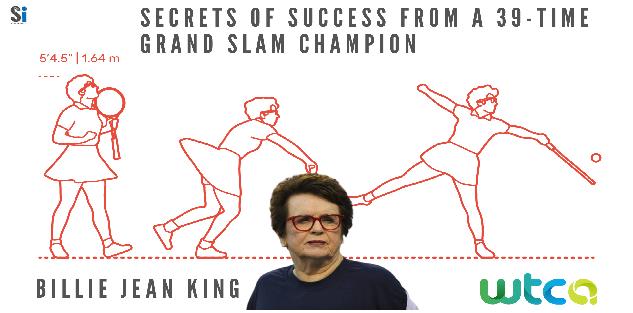Featured courses
- Four Tips to Turn Your Tennis Forehand Into a Weapon by Grant Young
- Tennis Legend Billie Jean King’s 4 Responsibilities as a Player by Grant Young
- Two Top Priorities For Success in Doubles Tennis by Grant Young
- Three of Tennis Whiz Lisa Dodson’s Tips to Improve Serves by Grant Young
- Three Elite Tennis Ball Machine Drills by Grant Young
- Three Keys For Correcting Tennis Serving Mechanics by Grant Young
- Five Tactical Tips to Win More Tennis Matches by Grant Young
- 4 Lessons Patrick Mouratoglou Learned From Coaching Serena Williams by Grant Young
- Four Effective Backhand Tennis Drills by Grant Young
- Two of Legendary Tennis Coach Paul Annacone’s Crucial Player Development Tips by Grant Young
- A Step-By-Step Guide To Mastering The Serve by Krsto Arsenijevic
- How to Dominate the Clay Court in Tennis by Krsto Arsenijevic
- 10 Essential Tennis Drills Every Coach Should Know by Brandon Ogle
- 8 Pre-Game Exercises to Prime Your Tennis Team for Competition by Neil Brown
- 7 Proven Tips To Develop Your Net Game in Tennis by Krsto Arsenijevic
- 10 Essential Tennis Drills Every Coach Should Know by Krsto Arsenijevic
- Developing Players - Two-handed backhand by Ramon Osa
- 6 Simple Warm-up Exercises For Tennis Players by Krsto Arsenijevic
- How to Beat a Serve-and-Volley Player by Krsto Arsenijevic
- How To Build Your Kinetic Chain Like Djokovic by Aiden Lefebvre
- How to neutralize a lefty in Tennis by Aiden Lefebvre
- 5 Tips To Improve Your Tennis Game Today by Krsto Arsenijevic
- Everything You Need to Know Before Buying New Tennis Shoes by Brandon Ogle
- Amp up your tennis practice with situational play by Neil Brown
- Tennis Equipment List by Brandon Ogle
- How to Master The One-handed Backhand in Tennis by Krsto Arsenijevic
- Modern High School Tennis Coaching Obstacles by Neil Brown
- Increase Your Tennis Fitness Level With 3 Easy Drills by Krsto Arsenijevic
- How to Successfully Hit a Two-Handed Backhand by Brandon Ogle
- How to Become a Grass Court Specialist in Tennis by Brandon Ogle
- How to Dominate the Hard-Court like Serena Williams by Brandon Ogle
- Hit a Drop Shot to Keep Your Opponent Off-Balance by Brandon Ogle
- New Tennis Injury Findings Linked to Neutral & Closed Stances by Oscar Wegner
- CHATTING WITH TENNIS PRO BRUCE CONNORS by Brandon
- How to Become a Mentally Strong Tennis Player by Brandon Ogle
- How to Win the Game of Angles by Hitting Cross-Court Shots by Eric Mahnke

How to Win the Game of Angles by Hitting Cross-Court Shots
- By Eric Mahnke
“The rule in life is like with tennis: One point won’t lose you the match, but if you let it get to you, it will.”
This tennis quote is one I always urge young tennis players to take to heart. When playing tennis, you can’t be afraid to take chances. If you are consistently hitting the ball right back towards the center of the court, the game becomes monotonous for yourself and easy for your opponent. Once a player knows what their opponent is trying to do, there are no secrets anymore. A cross-court shot can be one of many plays to keep them guessing.
More Court to Aim For For
It may not always seem this way, but on a standard tennis court there is a lot of room to hit at. With this said, one of my top reasons for hitting cross-court shots is to take advantage of this open real estate. When you hit one straight down the line, there isn’t a whole lot of room for error. However, this distance increases when you look for cross-court shots. This difference is even greater when you take the floor for a doubles match. Even though this point may sound a little elementary, it can pay significant dividends for the mental aspect of a match. When you realize that you have a few extra feet when opting to hit it cross-court rather than down the line, isn’t it safe to say you might attempt these shots more often?
Change Arm Anglesgles
In order to hit cross-court shots consistently, you have to adopt a different contact point and alignment than the one used for down the line shots. If you keep both of these the same, then you’re merely hitting cross-court shots by changing the swing angle with your wrist. When you do this, it becomes difficult to hit accurate shots consistently and thus unforced errors will start to grow in numbers. The best way to prevent this from happening is to change the contact point. Naturally, players will hit in-front inside balls to the cross court. Meanwhile, balls that are farther back and away from your body will tend to go down the line. With this known, the best way to hit cross-court shots is to position yourself so you’ll hit the ball a little earlier and closer in to the body. Proceeding in this approach will allow you to hit cross courts efficiently and effectively.
Occasionally a cross-court shot will take the form of a volley. CoachTube provides videos designed to help players master this skill.
Disguise Your ShotShot
The Problem
In a decent amount of the sports articles I’ve written, I always discuss this concept of ‘deception.’ Athletes are constantly trying to get an idea of what their opponent is thinking. If you are able to do this, you’re in a position of always being a step ahead. You know what move is coming before it happens. If your opponent is successful in breaking down your game, your chances of a victory quickly diminish. That is why you need to cleverly disguise your intentions. This applies perfectly for the difference between cross-court and down the line shots. While I’ll break down this difference later, you don’t want your opponent to know, based on your alignment, whether the ball is going cross-court or down the line.
The Solution
It is not recommended that you try to disguise all your shots, because it can lead to a loss in maximum power caused by overthinking. When you do find an opportunity to hit cross-court, you will align yourself as if you’re going for a down the line shot to deceive your opponent. Then position yourself a little further from the ball, and just as you begin the swing, start to pull yourself in and complete the cross-court. Like I mentioned, don’t try to disguise all of your shots, or else you will end up affecting your game in a negative way. The best advice is to only try to disguise the ones where you have extra time. Your opponent is already in a bad position if you have a decent amount of time to make the return, but this can ultimately finish the point!
<Disrupt Rhythmythm
As a tennis player myself, I understand the value that can be had from getting in a rhythm. Particularly when it’s your service game, you can quickly get in a groove when you’re getting your shots in. This can be further exemplified when your opponent isn’t putting a lot of pressure on you. When they’re simply hitting returns straight down the court, the game comes much easier. Cross-court shots are not only smarter shots, but they allow you to play to the weaknesses of your opponent. The majority of players are either going to be weaker with their forehand or backhand. During the early stages of the game, you need to find out which. Then, as the match progresses, you can consistently hit to their weak side, even when it requires a cross-court shot. This will keep them on-guard and hopefully prevent any momentum from occurring.
Comparison Between Down-the-Line Shots and Cross-Courtourt
In tennis, there are two primary types of passing shots: down-the-line and cross-court. A passing shot is essentially a groundstroke that makes the opposing player move to their right or left. A down-the-line never crosses the centerline and goes in a parallel direction of where the player is standing. Meanwhile, the cross-court shot crosses the centerline and goes from the left to right or vice versa.
If you intend on hitting a down-the-line shot off a cross-court, it requires a great deal of force. This is because you have to redirect the ball in a different direction. In addition, it helps to move your body into the ball and align properly so the wrists won’t be doing all the work. When you hit a cross-court shot, you run into similar issues. It is vital to position yourself appropriately to prevent any inconsistencies. Cross-courts require a hit that is more in front. Understanding how to position yourself is vital to hitting consistently on all passing shots.
<Take Advantage and Capitalizelize
Cross-court shots tend to be safer with the additional court to aim for. Even if you might be hesitant to hit cross-court often, I recommend slowing working it into your game. Excelling at tennis is largely centered on one’s ability to develop an all-around game. Just like a baseball pitcher, the more tools you have in your arsenal, the better player you’ll be. Hitting cross-court is yet another one of these tools every player should know.



